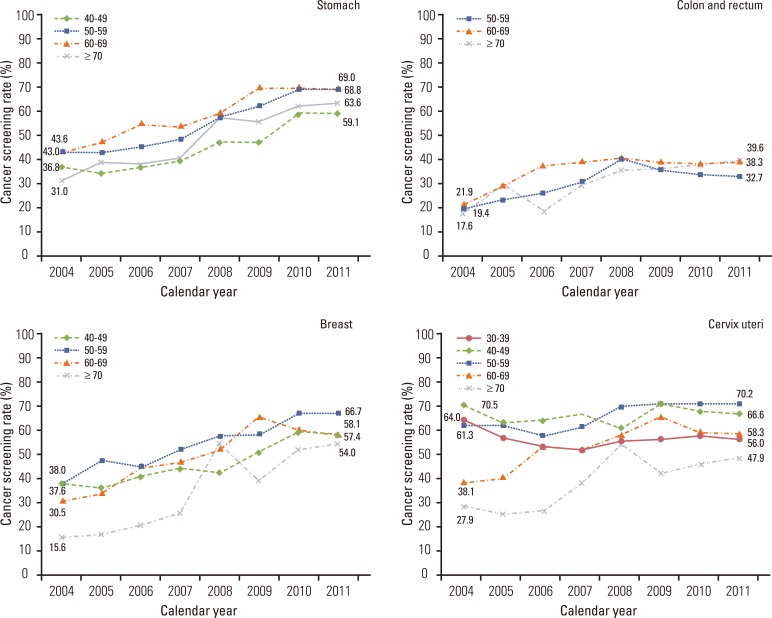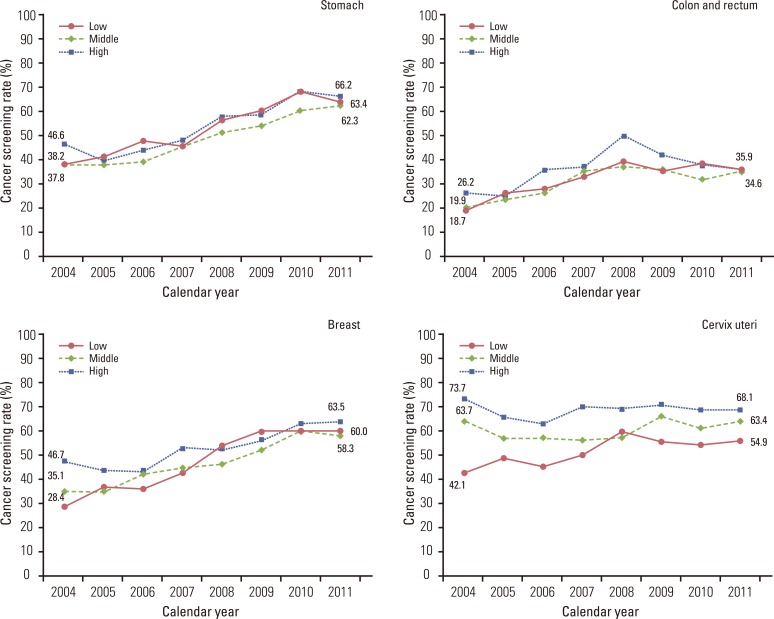Cancer Res Treat.
2012 Jun;44(2):113-120.
Trends in Cancer Screening Rates among Korean Men and Women: Results from the Korean National Cancer Screening Survey (KNCSS), 2004-2011
- Affiliations
-
- 1National Cancer Control Institute, National Cancer Center, Goyang, Korea. jkjun@ncc.re.kr
Abstract
- PURPOSE
The Korean National Cancer Screening Survey (KNCSS) is a nationwide survey conducted annually, since 2004. This study was conducted in order to report on trends in rates of cancer screening for five major cancers-stomach, liver, colorectal, breast, and cervix uteri in Korea.
MATERIALS AND METHODS
Data collected by the KNCSS between 2004 and 2011 were used in this study. The eligible study population included cancer-free men who were 40 years old and over, and women who were 30 years old and over. Lifetime screening rate, screening rate with recommendation, and changes in annual rates were calculated.
RESULTS
Both lifetime screening rates and screening rates with recommendation have increased since 2004. On average, screening rates with recommendation have shown an annual increase of 4.2% (95% CI, 3.3 to 5.2%) for stomach cancer, 1.1% (95% CI, -0.5 to 2.7%) for liver cancer, 2.2% (95% CI, 0.8 to 3.6%) for colorectal cancer, 4.0% (95% CI, 3.0 to 4.9%) for breast cancer, and 0.2% (95% CI, -0.9 to 1.3%) for cervical cancer. Increases in rates of cancer screening, with the exception of liver and cervical cancers, were significant, and screening rates for stomach and breast cancer in particular showed a marked increase.
CONCLUSION
Cancer screening rates among Koreans showed a consistent increase from 2004 to 2011 and rates of screening for gastric, breast, and cervical cancer are approaching 70%.
MeSH Terms
Figure
Reference
-
1. National Cancer Information Center, 2009. Cancer Statistics [Internet]. 2009. cited 2012 Jan 31. Goyang: National Cancer Information Center;Available from: http://www.cancer.go.kr/ncic/index.html .2. Lee KS, Oh DK, Han MA, Lee HY, Jun JK, Choi KS, et al. Gastric cancer screening in Korea: report on the national cancer screening program in 2008. Cancer Res Treat. 2011; 43:83–88. PMID: 21811423.
Article3. Oh DK, Shim JI, Han M, Kim Y, Lee HY, Jun JK, et al. Breast cancer screening in Korean women: report of the National Cancer Screening Program in 2008. J Breast Cancer. 2010; 13:299–304.
Article4. Lee EH, Han MA, Lee HY, Jun JK, Choi KS, Park EC. Liver cancer screening in Korea: a report on the 2008 National Cancer Screening Programme. Asian Pac J Cancer Prev. 2010; 11:1305–1310. PMID: 21198282.5. Shim JI, Kim Y, Han MA, Lee HY, Choi KS, Jun JK, et al. Results of colorectal cancer screening of the national cancer screening program in Korea, 2008. Cancer Res Treat. 2010; 42:191–198. PMID: 21253320.
Article6. Jun JK, Choi KS, Jung KW, Lee HY, Gapstur SM, Park EC, et al. Effectiveness of an organized cervical cancer screening program in Korea: results from a cohort study. Int J Cancer. 2009; 124:188–193. PMID: 18785204.
Article7. Miles A, Cockburn J, Smith RA, Wardle J. A perspective from countries using organized screening programs. Cancer. 2004; 101(5 Suppl):1201–1213. PMID: 15316915.
Article8. Kim HJ, Fay MP, Feuer EJ, Midthune DN. Permutation tests for joinpoint regression with applications to cancer rates. Stat Med. 2000; 19:335–351. PMID: 10649300.
Article9. Han MA, Choi KS, Park JH, Moore MA, Park EC. Midcourse evaluation of the second-term 10-year plan for cancer control in Korea. Asian Pac J Cancer Prev. 2011; 12:327–333. PMID: 21517281.10. Smith RA, Cokkinides V, Brooks D, Saslow D, Brawley OW. Cancer screening in the United States, 2010: a review of current American Cancer Society guidelines and issues in cancer screening. CA Cancer J Clin. 2010; 60:99–119. PMID: 20228384.
Article11. National Cancer Institute. Cancer trends progress report: 2009/2010 update. Breast cancer screening [Internet]. 2010. cited 2012 Jan 5. Bethesda, MD: National Cancer Institute;Available from: http://progressreport.cancer.gov/doc_detail.asp?pid=1&did=2009&chid=92&coid=916&mid=#trends .12. National Cancer Institute. Cancer trends progress report: 2009/2010 update. Cervical cancer screening [Internet]. 2010. cited 2012 Jan 5. Bethesda, MD: National Cancer Institute;Available from: http://progressreport.cancer.gov/doc_detail.asp?pid=1&did=2009&chid=92&coid=917&mid=#trends .13. National Cancer Institute. Cancer trends progress report: 2009/2010 update. Colorectal cancer screening [Internet]. 2010. cited 2012 Jan 5. Bethesda, MD: National Cancer Institute;Available from: http://progressreport.cancer.gov/doc_detail.asp?pid=1&did=2009&chid=92&coid=918&mid= .14. NHS Cancer Screening Programmes. NHS breast screening programme 2011 annual review [Internet]. 2011. cited 2012 Jan 5. Sheffield: NHS Cancer Screening Programmes;Available from: http://www.cancerscreening.nhs.uk/cervical/publications/cervical-annual-review-2011.pdf .15. NHS Cancer Screening Programmes. Breast cancer screening programme, England 2008-09 [Internet]. 2011. cited 2012 Jan 5. Sheffield: NHS Cancer Screening Programmes;Available from: http://www.cancerscreening.nhs.uk/breastscreen/breast-statistics-bulletin-2008-09.pdf .16. NHS Cancer Screening Programmes. NHS Cervical Screening Programme: annual review 2011 [Internet]. 2010. cited 2012 Jan 5. Sheffield: NHS Cancer Screening Programmes;Available from: http://www.cancerscreening.nhs.uk/cervical/publications/cervical-annualreview-2011.pdf .17. NHS Cancer Screening Programmes. NHS Bowel cancer screening programme [Internet]. 2010. cited 2012 Jan 5. Sheffield: NHS Cancer Screening Programmes;Available from: http://www.cancerscreening.nhs.uk/bowel/index.html .18. Yoshida M, Kondo K, Tada T. The relation between the cancer screening rate and the cancer mortality rate in Japan. J Med Invest. 2010; 57:251–259. PMID: 20847525.
Article19. Caplan LS, McQueen DV, Qualters JR, Leff M, Garrett C, Calonge N. Validity of women's self-reports of cancer screening test utilization in a managed care population. Cancer Epidemiol Biomarkers Prev. 2003; 12(11 Pt 1):1182–1187. PMID: 14652278.20. Hoffmeister M, Chang-Claude J, Brenner H. Validity of self-reported endoscopies of the large bowel and implications for estimates of colorectal cancer risk. Am J Epidemiol. 2007; 166:130–136. PMID: 17456475.
Article21. Jones RM, Mongin SJ, Lazovich D, Church TR, Yeazel MW. Validity of four self-reported colorectal cancer screening modalities in a general population: differences over time and by intervention assignment. Cancer Epidemiol Biomarkers Prev. 2008; 17:777–784. PMID: 18381476.
Article22. Park B, Lee YK, Cho LY, Go UY, Yang JJ, Ma SH, et al. Estimation of nationwide vaccination coverage and comparison of interview and telephone survey methodology for estimating vaccination status. J Korean Med Sci. 2011; 26:711–719. PMID: 21655054.
Article23. Ock SM, Choi JY, Cha YS, Lee J, Chun MS, Huh CH, et al. The use of complementary and alternative medicine in a general population in South Korea: results from a national survey in 2006. J Korean Med Sci. 2009; 24:1–6. PMID: 19270805.
Article24. OECD indicators, 2009. Screening, survival and mortality for breast cancer: OECD iLibrary, health at a glance 2011 [Internet]. 2011. cited 2012 Jan 5. OECD iLibrary;Available at: http://www.oecd-ilibrary.org/ .25. OECD indicators, 2009. Screening, survival and mortality for cervical cancer: OECD iLibrary, health at a glance 2011 [Internet]. 2011. cited 2012 Jan 5. OECD iLibrary;Available at: http://www.oecd-ilibrary.org/ .
- Full Text Links
- Actions
-
Cited
- CITED
-
- Close
- Share
- Similar articles
-
- Trends in Cancer Screening Rates among Korean Men and Women: Results from the Korean National Cancer Screening Survey (KNCSS), 2004-2010
- Trends in Cancer Screening Rates among Korean Men and Women: Results of the Korean National Cancer Screening Survey, 2004–2018
- Trends in Cancer-Screening Rates in Korea: Findings from the National Cancer Screening Survey, 2004-2023
- Trends in Cancer Screening Rates among Korean Men and Women: Results from the Korean National Cancer Screening Survey, 2004-2012
- Trends in Cancer Screening Rates among Korean Men and Women: Results of the Korean National Cancer Screening Survey, 2004-2013




